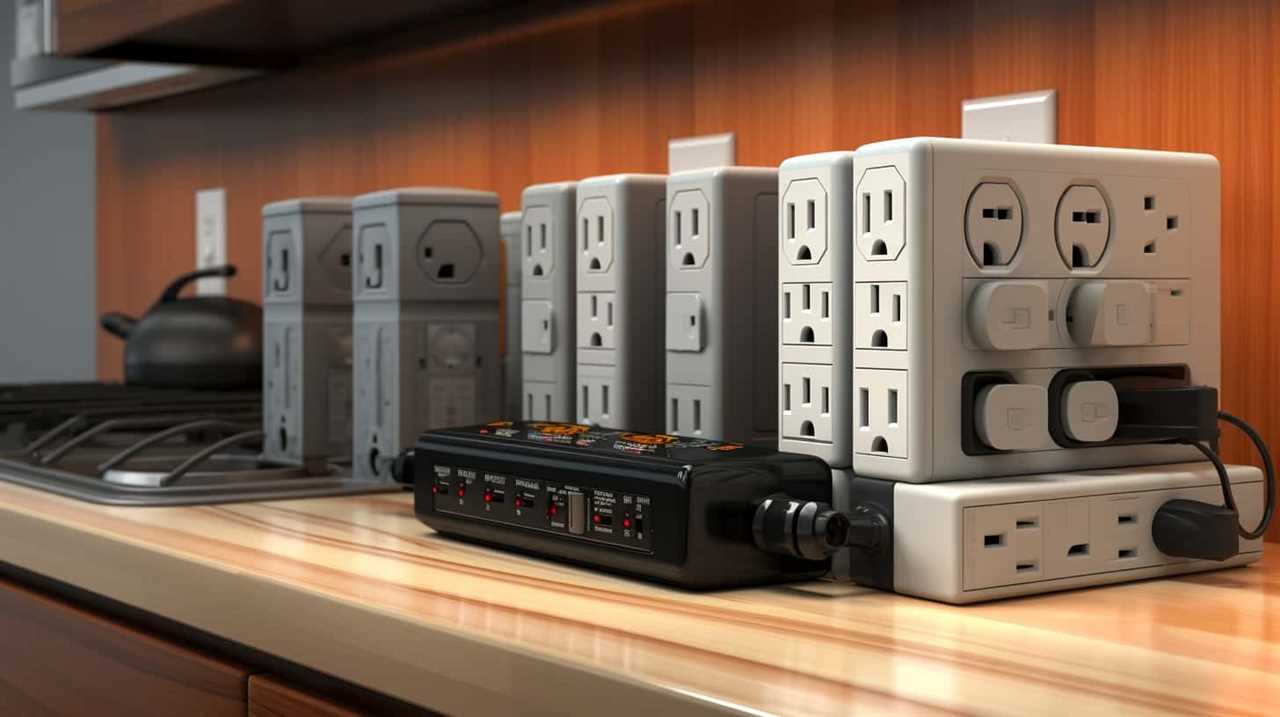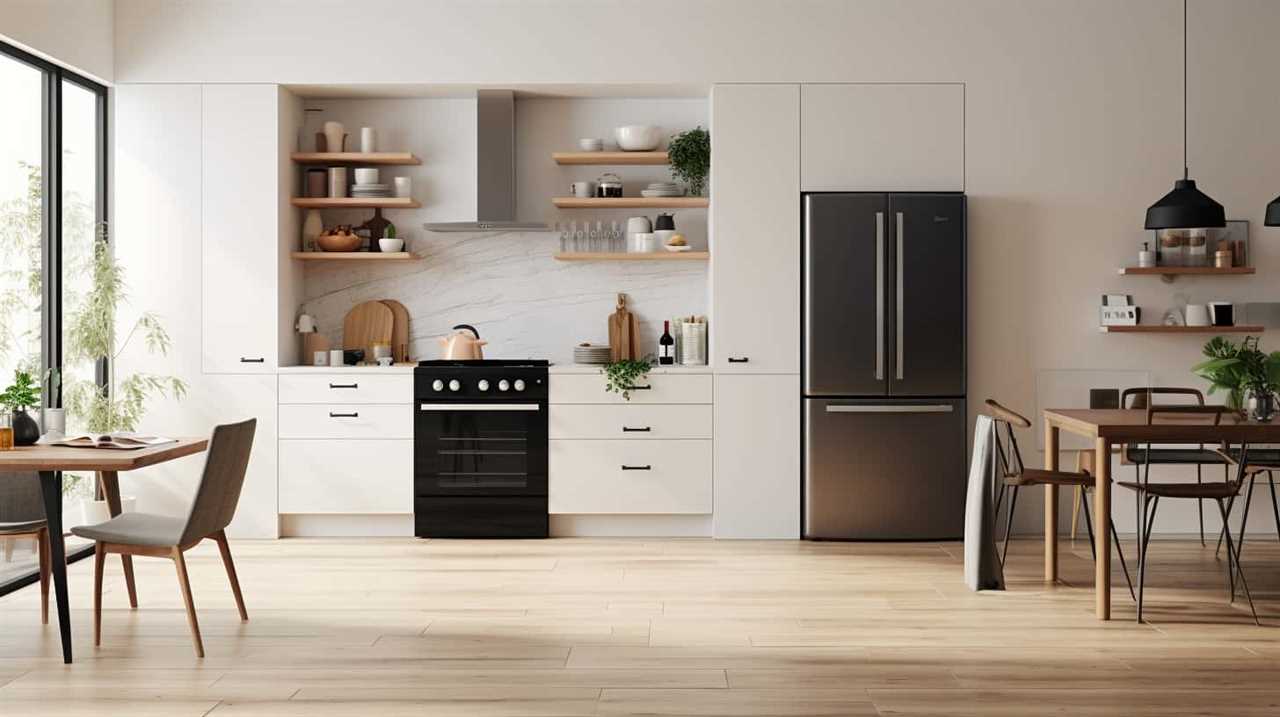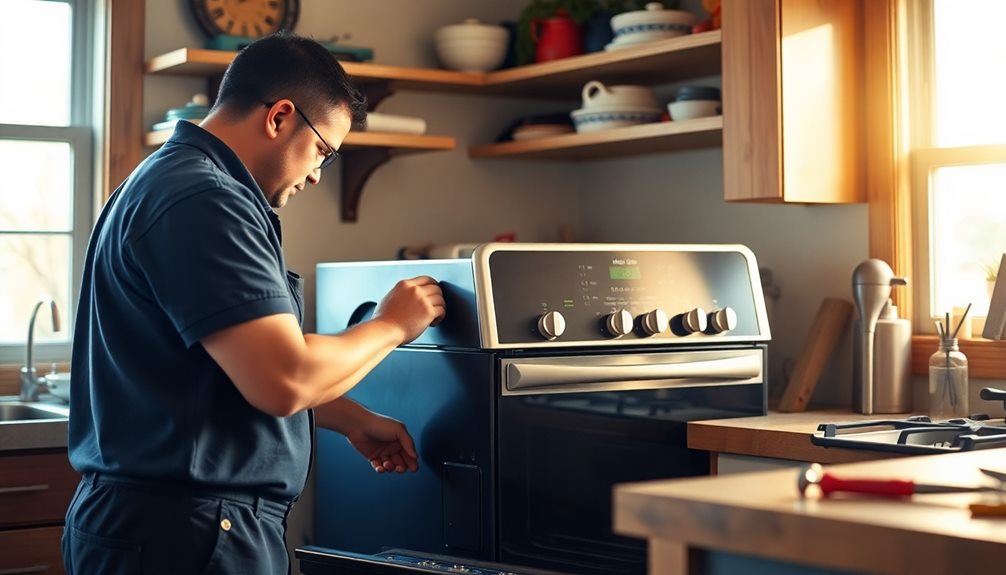As homeowners, we all aim for cozy and comfortable living spaces. With technology advancing, there are seven cutting-edge tech upgrades for home heating systems that can transform how we manage indoor climate control.
From smart thermostats that learn our preferences and adjust temperature accordingly, to energy monitoring systems that help us track and manage our energy usage, these advancements provide us with mastery over our home’s heating efficiency.
With wireless temperature sensors and zone heating solutions, we can personalize the temperature in different areas of our homes, ensuring optimal comfort wherever we go.
Additionally, remote control heating, advanced heat pump technology, programmable heating schedules, and smart home integration make managing our heating systems effortless and energy-efficient.

Finally, energy-efficient insulation helps retain warmth, reducing energy waste.
It’s time to embrace these seven innovative upgrades and transform our homes into havens of comfort and efficiency.
Key Takeaways
- Smart heating controls, such as smart thermostats, offer advanced scheduling options and remote access through smartphone apps or web portals.
- Energy efficiency and optimization can be achieved through the use of energy monitoring systems, zone heating solutions, and energy-efficient insulation.
- Convenience and automation are possible with features like remote control heating, voice-activated controls, and enhanced home automation.
- Air quality and purification can be improved by integrating air purification systems and utilizing radiant floor heating.
Smart Thermostats
We’ve upgraded our home heating systems with smart thermostats to maximize efficiency and control our energy usage. These advanced devices offer a range of energy-saving features and temperature automation capabilities that significantly improve the overall performance of our heating systems.
One of the key energy-saving features of smart thermostats is their ability to learn our heating patterns and adjust the temperature accordingly. By analyzing our usage patterns, these thermostats can automatically lower the temperature when we’re away and raise it just before we return, ensuring optimal comfort while reducing energy wastage.

In addition to the learning capabilities, smart thermostats also come with advanced scheduling options. We can set specific temperature preferences for different times of the day or days of the week. This allows us to easily manage our heating system based on our daily routines, without the need for constant manual adjustments.
Furthermore, smart thermostats provide remote access through smartphone apps or web portals, allowing us to control the temperature of our homes from anywhere. This feature is particularly useful when we’re away and want to ensure a comfortable temperature upon our return, or when unexpected changes in plans require adjustments to our heating settings.
Energy Monitoring Systems
To enhance our understanding of energy usage and improve efficiency, we’ve implemented energy monitoring systems in our home heating systems. These systems provide numerous benefits, allowing us to track and analyze our real-time energy consumption. Here are five key advantages of energy monitoring systems:
- Optimized energy usage: Energy monitoring systems enable us to identify energy wastage and make informed decisions to optimize energy usage. We can identify patterns and trends in energy consumption, allowing us to make adjustments and reduce energy waste.
- Cost savings: By closely monitoring energy consumption, we can identify areas where energy is being wasted and take steps to reduce it. This leads to significant cost savings on our energy bills over time.
- Improved efficiency: Energy monitoring systems provide valuable insights into the efficiency of our heating systems. By analyzing real-time energy consumption data, we can identify any inefficiencies and take corrective measures to improve the overall efficiency of our home heating systems.
- Environmental impact: By tracking our energy consumption, we can assess our carbon footprint and take steps to reduce it. Energy monitoring systems help us make informed choices that align with our sustainability goals.
- Smart energy management: Energy monitoring systems can be integrated with other smart home devices, such as smart thermostats, to create a comprehensive energy management system. This allows us to automate and optimize our energy usage for maximum efficiency and comfort.
With energy monitoring systems in place, we’ve a powerful tool to track, analyze, and optimize our energy consumption, leading to significant benefits in terms of cost savings, efficiency improvements, and reduced environmental impact.

Zone Heating Solutions
Zone heating solutions offer a customizable and efficient way to control the temperature in different areas of our home heating systems. One such solution is radiant floor heating, which involves installing a network of pipes or electric heating elements beneath the floor surface. These pipes or elements emit heat directly to the floor, which then radiates warmth to the surrounding space. This method provides a more even and comfortable heat distribution compared to traditional forced-air systems.
Radiant floor heating can be controlled using zone heating systems, allowing you to adjust the temperature in specific areas of your home independently. This means you can keep the living room cozy and warm while keeping the bedroom cooler during the night. By dividing your home into zones, you can optimize energy usage and reduce heating costs.
Zone heating solutions also offer the convenience of programmable thermostats, allowing you to set different temperature schedules for each zone. For example, you can have the kitchen warm up in the morning, the living room comfortable during the day, and the bedrooms cool at night. This level of customization ensures that each area of your home is heated according to your preferences and lifestyle.
Wireless Temperature Sensors
Moving on to wireless temperature sensors, another innovative tech upgrade in home heating systems is the integration of these sensors for enhanced temperature monitoring and control. Wireless temperature sensors utilize smart sensor technology to provide accurate and real-time readings of the temperature in different areas of a home. Here are five key advantages of incorporating wireless temperature sensors into your heating system:

- Improved accuracy: Wireless temperature sensors offer precise temperature measurements, ensuring optimal comfort levels in every room.
- Remote monitoring and control: With wireless connectivity, you can monitor and control the temperature of your home from anywhere using a smartphone or computer.
- Energy efficiency: By accurately monitoring temperature, wireless sensors enable you to adjust heating settings efficiently, resulting in energy savings and reduced utility bills.
- Zoning capabilities: Wireless sensors can be integrated with zoning systems, allowing you to customize temperature settings for different areas of your home based on occupancy and usage patterns.
- Enhanced comfort and convenience: With wireless temperature sensors, you can effortlessly maintain a comfortable environment throughout your home, without the need for manual adjustments.
Remote Control Heating
One of the innovative tech upgrades in home heating systems is the integration of remote control heating, which allows us to adjust the temperature settings from anywhere in the house. With remote control programming, we can conveniently set the desired temperature without having to physically interact with the thermostat. This feature not only adds convenience but also contributes to energy savings by allowing us to adjust the temperature based on our needs and schedule.
Remote control heating systems often come with energy-saving features that further enhance their efficiency. For example, some systems have occupancy sensors that detect whether a room is occupied or not. If a room is unoccupied for a certain period, the system can automatically adjust the temperature to save energy. Additionally, some systems can learn our heating preferences and create personalized schedules to optimize energy usage.
To illustrate the benefits of remote control heating, consider the following table showcasing a comparison between a traditional thermostat and a remote control heating system:
| Features | Traditional Thermostat | Remote Control Heating |
|---|---|---|
| Adjust temperature remotely | No | Yes |
| Energy-saving features | Limited | Extensive |
| Learning capabilities | No | Yes |
| Occupancy detection | No | Yes |
As we can see, remote control heating systems offer significant advantages over traditional thermostats, providing greater control, energy savings, and customization options. However, voice-activated controls take this convenience to the next level.

Transition: Now let’s explore the exciting world of voice-activated controls and how they are revolutionizing home heating systems.
Voice-Activated Controls
Voice-activated controls have revolutionized the way we interact with our home heating systems. With the convenience of simply speaking commands, homeowners can effortlessly adjust the temperature, set schedules, and even control different zones within their homes.
Not only does this technology offer unparalleled convenience, but it also contributes to increased energy efficiency by allowing for precise temperature control and reducing wasted energy.
Furthermore, voice-activated controls seamlessly integrate with other smart home devices, enhancing home automation capabilities and creating a truly connected and efficient living environment.

Convenience of Voice Control
We find it incredibly convenient to control our home heating systems with just our voices. Voice recognition technology has revolutionized the way we interact with our homes, allowing us to effortlessly adjust the temperature without lifting a finger. Here are five reasons why voice-activated controls are a game-changer for home heating systems:
- Hands-free operation: With voice control, we can adjust the temperature or turn the heating system on and off without needing to physically interact with any buttons or devices.
- Seamless integration with home assistants: Voice-activated controls seamlessly integrate with popular home assistant devices like Amazon Echo or Google Home, allowing us to control our heating systems using familiar voice commands.
- Enhanced accessibility: Voice control provides a convenient solution for individuals with mobility issues or disabilities, enabling them to easily manage their home heating systems.
- Time-saving convenience: Voice commands eliminate the need to manually adjust the thermostat or navigate through complex menus, saving us time and effort.
- Personalized experiences: Voice recognition technology can learn our preferences, allowing us to create personalized heating schedules or set specific temperature presets with simple voice commands.
Increased Energy Efficiency
The implementation of voice control technology in home heating systems has significantly improved energy efficiency. By allowing homeowners to control their heating systems using voice commands, energy-saving tips can be easily implemented.
For example, users can adjust the temperature in specific rooms or zones, ensuring that energy isn’t wasted in unoccupied areas. Additionally, voice-activated controls enable homeowners to schedule heating cycles based on their daily routines, optimizing energy usage and reducing unnecessary heating.
This technology also integrates with green heating options, such as smart thermostats that can learn and adapt to users’ preferences over time. Voice-activated controls provide a convenient and efficient way to manage home heating systems, resulting in reduced energy consumption and lower utility bills.

Enhanced Home Automation
With the implementation of voice control technology, homeowners can seamlessly integrate enhanced home automation into their heating systems. This advancement allows for a more convenient and efficient way to control the temperature of your home.
Here are five ways that voice-activated controls can enhance home automation:
- Increased Home Security: Voice-activated controls can be integrated with home security systems, allowing homeowners to arm or disarm their alarm systems using simple voice commands.
- Entertainment Integration: By linking voice control technology with entertainment systems, homeowners can effortlessly adjust audio levels, change TV channels, or even select their favorite movies or music.
- Smart Thermostat Control: Voice-activated controls enable homeowners to adjust the temperature of their home hands-free, creating a more comfortable living environment.
- Customizable Settings: With voice control technology, homeowners can create personalized settings for different times of the day or different areas of the house, optimizing energy usage and comfort.
- Remote Accessibility: Voice-activated controls can be accessed remotely through mobile devices, allowing homeowners to control their heating systems even when they’re away from home.
These advancements in home automation provide homeowners with a more seamless and intuitive way to control their heating systems while also enhancing home security and entertainment integration.
Air Purification Integration
When it comes to home heating systems, one innovative tech upgrade that homeowners should consider is the integration of air purification features.

With built-in air purifiers, these systems can effectively filter out pollutants and allergens, resulting in cleaner indoor air quality.
This integration not only provides a more comfortable living environment but also promotes better respiratory health for occupants.
Built-In Air Purifiers
One of the most notable upgrades in home heating systems is the incorporation of built-in air purifiers, which greatly enhance indoor air quality. These innovative devices have revolutionized the way we heat and purify the air in our homes, offering a range of benefits that go beyond traditional heating systems.
Here are five key features of built-in air purifiers:

- High-efficiency particulate air (HEPA) filters: These filters can capture up to 99.97% of airborne particles, including dust, pollen, and pet dander.
- Activated carbon filters: These filters are effective in removing odors, chemicals, and volatile organic compounds (VOCs) from the air.
- UV germicidal lamps: These lamps use ultraviolet light to kill bacteria, viruses, and other microorganisms, improving indoor air quality.
- Smart sensors: These sensors monitor air quality in real-time and adjust the purifier’s settings accordingly, ensuring optimal performance.
- Quiet operation: Built-in air purifiers are designed to operate silently, allowing you to enjoy clean air without any disturbance.
With the integration of air purification technology, home heating systems have become more than just a source of warmth – they’re now essential tools for creating a healthy and comfortable indoor environment.
Cleaner Indoor Air
Another important upgrade in home heating systems is the integration of air purification technology, which further enhances indoor air quality. Air purification systems are designed to remove pollutants, allergens, and other harmful particles from the air, creating a cleaner and healthier living environment.
These systems use a combination of filters and advanced technologies such as UV light and electrostatic precipitators to capture and eliminate contaminants. By incorporating air purification into home heating systems, homeowners can enjoy the benefits of cleaner indoor air without the need for separate devices.
This integration not only improves indoor air quality but also provides convenience and energy efficiency. Additionally, when combined with energy-efficient insulation, the air purification system can work more effectively, ensuring that the air circulated in the home is clean and free from pollutants.

Radiant Floor Heating
We have discovered seven innovative tech upgrades in home heating systems, and the first one we’ll explore is radiant floor heating. This cutting-edge heating system utilizes the floor as a source of warmth, providing a comfortable and efficient solution for heating homes.
Here are five key aspects of radiant floor heating:
- Energy Efficiency: Radiant floor heating is highly energy-efficient, using lower water temperatures and reducing heat loss compared to traditional heating methods. This results in lower energy consumption and cost savings for homeowners.
- Comfort: With radiant floor heating, heat is evenly distributed throughout the room, eliminating hot and cold spots. This creates a cozy and comfortable living environment, allowing you to walk barefoot on warm floors even during the coldest winter days.
- Geothermal Heating: Radiant floor heating can be combined with geothermal systems, utilizing the earth’s natural heat to provide warmth. This renewable energy source ensures sustainable and eco-friendly heating for your home.
- Solar Powered Heating: By integrating radiant floor heating with solar panels, you can harness the power of the sun to heat your home. Solar-powered radiant floor heating systems reduce your carbon footprint and reliance on traditional energy sources.
- Health Benefits: Unlike forced-air systems that circulate dust and allergens, radiant floor heating doesn’t disturb the air, improving indoor air quality and reducing the risk of allergies or respiratory issues.
Radiant floor heating offers a modern and efficient solution for home heating, providing comfort, energy savings, and environmental sustainability.
Geothermal Heating Systems
Geothermal heating systems offer a sustainable and environmentally friendly solution for home heating, harnessing the earth’s natural heat to provide warmth. These systems utilize the constant temperature of the earth, typically between 45 to 75 degrees Fahrenheit, to heat homes efficiently throughout the year.

The benefits of geothermal energy are numerous. First, it’s a renewable energy source, meaning it will never run out. Second, it produces no greenhouse gas emissions, making it an excellent choice for reducing carbon footprints. Additionally, geothermal systems can provide both heating and cooling, eliminating the need for separate heating and air conditioning units.
The installation process for geothermal heating systems involves several steps. First, a loop system is buried underground, either vertically or horizontally, depending on the available space. This loop system is filled with a water and antifreeze mixture that circulates through it. Next, a heat pump is installed inside the home, which transfers heat between the loop system and the house. The heat pump uses the constant temperature of the earth to either extract heat during colder months or deposit heat during warmer months. Finally, ductwork or radiant heating systems distribute the heated or cooled air throughout the home.
Solar-Powered Heating
Continuing our exploration of sustainable heating options, let’s now turn our attention to solar-powered heating. Solar heating systems are a great off-grid heating option that utilizes the sun’s energy to provide warmth and comfort in homes. Here are five key features and advantages of solar heating systems:
- Renewable Energy Source: Solar heating systems harness the power of the sun, which is a renewable and abundant energy source. By using solar energy, homeowners can reduce their carbon footprint and contribute to a cleaner environment.
- Cost Savings: Solar-powered heating can significantly reduce energy costs. Once installed, solar heating systems require minimal maintenance and can provide free heating for many years. This can lead to substantial savings on monthly utility bills.
- Versatility: Solar heating systems can be used for various purposes, including space heating, water heating, and heating swimming pools. They can be integrated into new or existing homes, offering flexibility in design and installation.
- Reliability: Solar heating systems are designed to operate efficiently even in cold climates. With the use of proper insulation and backup systems, homeowners can enjoy consistent heating throughout the year.
- Independence: Solar-powered heating allows homeowners to become less reliant on traditional energy sources. By going off-grid, they can have peace of mind knowing that their heating needs are met even during power outages or energy supply disruptions.
Solar heating systems offer an environmentally friendly and cost-effective solution for home heating. With their renewable energy source and off-grid capabilities, they’re an excellent choice for homeowners seeking sustainable and independent heating options.

Heat Recovery Ventilation
One commonly used technology in home heating systems is heat recovery ventilation, which efficiently circulates air and reduces energy waste. Heat recovery ventilation (HRV) systems are designed to provide fresh air to a home while also recovering heat from the outgoing air. This not only improves indoor air quality but also helps to maintain a comfortable and energy-efficient living environment.
One of the key features of heat recovery ventilation is its ability to transfer heat from the exhaust air to the incoming fresh air. This is achieved through the use of a heat exchanger, which allows the heat from the warm air to be transferred to the cooler air without mixing the two streams. By doing so, HRV systems can significantly reduce the energy required to heat incoming air during the winter months.
To further enhance the energy efficiency of home heating systems, it is important to consider the role of insulation. Energy efficient insulation helps to reduce heat loss from the home, thereby minimizing the amount of energy required to maintain a comfortable indoor temperature. By combining heat recovery ventilation with energy efficient insulation, homeowners can achieve optimal energy savings and create a more sustainable living environment.
The following table highlights the benefits of heat recovery ventilation and energy efficient insulation in home heating systems:

| Benefits of HRV and Energy Efficient Insulation |
|---|
| Improved indoor air quality |
| Reduced energy waste |
| Enhanced comfort and energy savings |
Advanced Heat Pump Technology
When it comes to home heating systems, advanced heat pump technology offers a range of benefits.
First and foremost, it provides an efficient and eco-friendly solution for heating your home. By transferring heat from one place to another, heat pumps can achieve high levels of energy efficiency, helping to reduce your carbon footprint.
Additionally, heat pumps are a cost-effective option, as they can provide both heating and cooling, eliminating the need for separate systems.
Lastly, these systems are versatile and adaptable, making them suitable for a variety of homes and climates.

Efficient and Eco-Friendly
We have found that incorporating advanced heat pump technology into home heating systems is an efficient and eco-friendly solution. With the growing importance of energy saving tips and green heating solutions, heat pumps offer a range of benefits that make them an ideal choice for homeowners seeking sustainable heating options.
Here are five reasons why advanced heat pump technology is a game-changer in home heating:
- Energy Efficiency: Heat pumps transfer heat from the outside air or ground, reducing the need for fossil fuels and consuming less energy compared to traditional systems.
- Lower Emissions: Heat pumps produce fewer greenhouse gas emissions, helping to combat climate change and improve air quality.
- Versatility: Heat pumps can provide both heating and cooling, eliminating the need for separate systems and improving overall energy efficiency.
- Constant Comfort: Heat pumps distribute heat evenly throughout the home, ensuring consistent temperature control and enhanced comfort.
- Cost Savings: By using renewable energy sources and consuming less electricity, heat pumps can significantly lower utility bills over time.
As we explore the efficient and eco-friendly benefits of advanced heat pump technology, it becomes clear that it’s a stepping stone towards our next topic: a cost-effective heating solution.
Cost-Effective Heating Solution
Now let’s delve into the cost-effective heating solution provided by advanced heat pump technology.

Heat pumps are an eco-friendly alternative to traditional heating systems, offering both cost-saving options and environmental benefits. These innovative systems work by extracting heat from the air or ground and transferring it into your home, providing efficient heating during the colder months.
One key advantage of heat pump technology is its high energy efficiency, as it can produce up to three times more heat energy than the electrical energy it consumes. This means lower energy bills and reduced carbon emissions.
Additionally, heat pumps can also provide cooling during the summer, further enhancing their value as an all-in-one heating and cooling solution.
Versatile and Adaptable
One notable feature of advanced heat pump technology is its versatility and adaptability, allowing homeowners to customize their heating and cooling needs efficiently. With its versatile design and adaptable technology, advanced heat pumps offer a range of benefits for homeowners seeking mastery over their home heating systems.

Here are five key advantages:
- Energy Efficiency: Advanced heat pumps are designed to operate at high efficiencies, delivering maximum heating and cooling output with minimal energy consumption.
- Zoning Capabilities: These heat pumps can be configured to divide a home into multiple zones, allowing for precise temperature control in different areas.
- Integration with Renewable Energy Sources: Advanced heat pumps can be seamlessly integrated with solar panels or geothermal systems, maximizing energy savings and reducing carbon footprint.
- Smart Home Compatibility: These heat pumps can be connected to smart home devices, enabling homeowners to control their heating and cooling remotely and optimize energy usage.
- Low Maintenance Requirements: With advanced technology, heat pumps require minimal maintenance, saving homeowners time and money.
With their versatile and adaptable design, advanced heat pumps provide homeowners with the flexibility and efficiency they desire in their heating and cooling systems.
Programmable Heating Schedules
With the addition of programmable heating schedules, our homes can now efficiently regulate temperature settings throughout the day. Programmable heating schedules allow homeowners to set specific temperature levels for different times of the day, ensuring optimal comfort and energy efficiency. These schedules can be easily customized to accommodate individual preferences and daily routines.
For example, you can program your heating system to lower the temperature when you’re away from home and raise it just before you return. By doing so, you can save energy and reduce heating costs.

Programmable heating schedules work in conjunction with energy monitoring systems to further enhance efficiency. Energy monitoring systems provide real-time data on energy usage, allowing homeowners to track their heating patterns and make adjustments as needed. This information can be accessed through a user-friendly interface, providing a comprehensive overview of energy consumption and costs.
Transition: Now that we’ve explored the benefits of programmable heating schedules and energy monitoring systems, let’s delve into the next exciting feature in home heating systems: smart home integration.
Smart Home Integration
We frequently incorporate smart home integration into our heating systems to enhance convenience and efficiency. By connecting our heating systems to smart home devices and platforms, homeowners can have full control over their heating systems and optimize energy usage. Here are five ways in which smart home integration enhances the functionality and performance of heating systems:
- Remote Control: With smart home integration, homeowners can control their heating systems from anywhere using their smartphones or tablets. This allows them to adjust the temperature, set schedules, and monitor energy usage even when they’re away from home.
- Integration with Smart Thermostats: Smart thermostats can be seamlessly integrated into the overall smart home system, allowing for automatic adjustments based on occupancy, weather conditions, and user preferences. This integration ensures optimal comfort and energy efficiency.
- Energy Saving Tips: Smart home integration provides valuable insights and energy-saving tips. Homeowners can receive personalized recommendations on reducing energy consumption, such as adjusting temperature settings or optimizing heating schedules.
- Smart Home Security: Smart home integration enables heating systems to be integrated with home security systems, enhancing overall safety and protection. For example, the heating system can be programmed to turn off when the security system is armed, providing peace of mind and energy savings.
- Voice Control: Integration with voice assistants, such as Amazon Alexa or Google Assistant, allows homeowners to control their heating systems using voice commands. This hands-free control adds convenience and ease of use.
Incorporating smart home integration into heating systems not only enhances convenience but also promotes energy efficiency and smart home security. With these innovations, homeowners can have full control over their heating systems, optimize energy usage, and enjoy a comfortable and secure living environment.

Energy-Efficient Insulation
When it comes to energy-efficient insulation in home heating systems, there are two key points to consider: smart thermostat integration and the use of renewable energy sources.
Smart thermostat integration allows for precise control over the heating system, ensuring optimal energy usage and reducing waste.
Additionally, incorporating renewable energy sources such as solar panels or geothermal systems can further enhance the energy efficiency of the overall heating system.
These upgrades not only help in reducing energy consumption but also contribute to a greener and more sustainable future.

Smart Thermostat Integration
By integrating smart thermostats into our home heating systems, we can achieve energy-efficient insulation through the use of advanced technology. Smart thermostats offer a range of energy-saving features that contribute to reducing heat loss and optimizing temperature control.
Here are five key benefits of smart thermostat integration:
- Smart thermostat compatibility: These devices can seamlessly integrate with existing heating systems, allowing homeowners to easily upgrade their insulation capabilities.
- Remote temperature control: Smart thermostats enable users to adjust the temperature of their homes remotely, giving them greater control over energy consumption.
- Learning capabilities: These thermostats can learn the occupants’ preferences and adjust the temperature accordingly, resulting in optimized energy usage.
- Energy usage monitoring: Smart thermostats provide real-time energy consumption data, empowering users to make informed decisions about their heating habits.
- Smart scheduling: These devices can create personalized heating schedules based on the users’ daily routines, further enhancing energy efficiency.
Renewable Energy Sources
Integrating renewable energy sources into our home heating systems enhances energy-efficient insulation. By utilizing renewable energy sources, such as solar panels or geothermal systems, we can significantly reduce our reliance on fossil fuels while maximizing the efficiency of our heating systems. These versatile heating solutions not only provide a more sustainable way to heat our homes but also offer long-term cost savings and environmental benefits.
Solar panels, for example, convert sunlight into electricity that can power our heating systems. This not only reduces our carbon footprint but also decreases our reliance on non-renewable energy sources. Geothermal systems, on the other hand, harness the natural heat from the earth to warm our homes. By tapping into this renewable energy source, we can achieve a more consistent and efficient heating solution throughout the year.

In addition to their energy-saving benefits, these renewable energy sources also contribute to better insulation. By incorporating energy-efficient insulation materials, such as insulated doors and windows, we can further enhance the performance of our heating systems. These materials help to trap heat inside our homes, reducing heat loss and improving overall energy efficiency.
Frequently Asked Questions
How Do Smart Thermostats Work and How Can They Help Improve Home Heating Efficiency?
Smart thermostats work by using sensors and algorithms to learn and adjust to your heating preferences, creating a personalized heating schedule.
By connecting to your Wi-Fi network, they allow remote control and monitoring through smartphone apps.
These thermostats can also integrate with other smart home devices, such as occupancy sensors and weather forecasts, to optimize heating efficiency.

This technology gives homeowners valuable energy-saving tips, like recommending lower temperatures while away or adjusting settings based on occupancy patterns.
Are There Any Specific Energy Monitoring Systems That Are Recommended for Homeowners Looking to Track and Optimize Their Heating Usage?
When it comes to optimizing heating usage and tracking energy consumption, there are several energy monitoring systems that homeowners can consider. These systems provide detailed insights into heating patterns and allow for efficient adjustments to be made.
From smart thermostats with built-in energy monitoring features to standalone energy monitoring devices that can be integrated into existing heating systems, there are options available to suit different needs and preferences.
What Are Some Key Benefits of Zone Heating Solutions and How Do They Differ From Traditional Heating Systems?
Zone heating solutions offer a multitude of benefits that set them apart from traditional heating systems.

By dividing the home into separate zones, each with its own thermostat, we can customize the temperature in each area to meet our specific needs. This not only maximizes comfort but also saves energy and reduces heating costs.
Additionally, zone heating allows for greater control over individual rooms, ensuring that everyone in the household is comfortable at all times.
How Do Wireless Temperature Sensors Contribute to a More Efficient and Comfortable Home Heating Experience?
Wireless temperature sensors play a crucial role in enhancing the efficiency and comfort of home heating systems. By wirelessly transmitting real-time temperature data to the heating system, these sensors enable precise and targeted heating control.
This eliminates the need for manual adjustments and ensures that each area of the home receives the appropriate amount of heat, resulting in energy savings and a more comfortable living environment.

With wireless temperature sensors, homeowners can enjoy a more efficient and tailored home heating experience.
Can You Explain How Remote Control Heating Works and What Features Homeowners Can Expect From This Type of System?
Remote control heating is a revolutionary technology that allows homeowners to control their heating systems remotely. With this system, we can easily adjust the temperature of our homes from anywhere using a smartphone or a computer.
The benefits of remote control heating are numerous. It allows us to save energy and money by only heating our homes when needed. Additionally, we can create personalized heating schedules and even receive notifications about our heating system’s performance.
This technology truly enhances our comfort and convenience.

How Do Innovative Tech Upgrades in Home Heating Systems Compare to Modern Air Conditioning Units?
Innovative tech upgrades in home heating systems have revolutionized the way we control indoor temperatures. However, modern air conditioning units technology has also made significant strides, offering enhanced energy efficiency and smart controls. Both systems aim to provide optimal comfort and convenience for homeowners, leading to a more sustainable and comfortable living environment.
Conclusion
In conclusion, these innovative tech upgrades in home heating systems offer a plethora of benefits for homeowners.
With smart thermostats, energy monitoring systems, and wireless temperature sensors, controlling and monitoring the temperature in our homes has become more convenient and efficient.
Additionally, zone heating solutions, remote control heating, and advanced heat pump technology provide personalized comfort and energy savings.
By integrating these systems into smart homes and ensuring energy-efficient insulation, homeowners can enjoy a cozy and cost-effective living environment.

Truly, these advancements have raised the bar in home heating technology.










